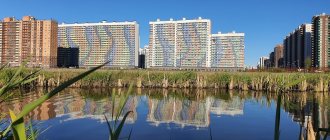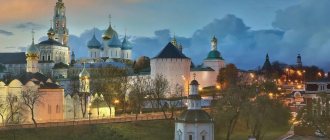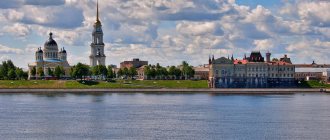The famous Russian Saint Seraphim received his nickname of Sarov from the locality where his spiritual formation took place in a local monastery. Nowadays the city of Sarov, where you can see a lot of interesting things, belongs to the Nizhny Novgorod region. A sacred place for Orthodox believers in the 20th century acquired completely different associations. The settlement became a center of nuclear development and received the status of a closed city. For some time it bore the names Kremlev and Arzamas-16. In 1995, the historical name returned. Tourist trips to Sarov are possible, but for this you need to order a pass in advance. It’s worth it, because behind the rows of barbed wire are hidden various attractions that introduce you to the glorious past of the settlement.
Holy Dormition Monastery
Hermitage Sarov is famous for the Holy Dormition Monastery. The construction of the temple began in 1897, when Seraphim of Sarov had not yet been canonized. Initially, the construction of the cathedral glorified the Holy Trinity. Since the temple was built over the elder’s cell, it was called that. After Seraphim of Sarov was canonized, the temple was immediately consecrated. This is the first Cathedral of St. Seraphim in Russia.
Inside the church was the saint’s cell, like the most precious shrine. The iconostasis looked quite simple. It was possible to walk around the cell and even go inside. Later the cell was painted and a small dome was placed on it. It took on the appearance of a chapel.
In 1927 the cathedral was closed. It was turned into a theater. In 2002, restoration work began, and already in August 2003, services began to be held in the temple again.
Reasons for closure
In 1927, the monastery ceased to exist, and on its territory the Labor Commune of the NKT (People's Commissariat of Labor) factory was located, where street children worked. The labor commune was more of an educational nature, where through labor they tried to re-educate young tramps, most of whom had already engaged in robbery and theft in the past. The total number of children living and working in the commune by 1931 was about 3.5 thousand.
After 1931, the Labor Commune was liquidated, and in its place a colony for NKVD prisoners was formed, which existed until 1938.
In November 1938, it was decided to establish the production of pressing equipment and high-explosive fragmentation shells of 152 mm caliber on the site of the former colony. And during the Great Patriotic War with Nazi Germany in the period from 1942-1943. here they manufactured shell casings for the world-famous Russian Katyusha rocket mortars. The plant was assigned the number 550, and according to statistics, every fifth shell fired at the enemy was manufactured at Sarov Plant No. 550.
After the war in 1946, a significant event took place for Sarov. It was decided to establish a secret facility for the creation of nuclear weapons on the territory of the city. From this moment on, Sarov becomes not just a closed city, but a secret object with the code name “Settlement KB-11” and disappears for a long time from all maps of the country.
Over the course of several years, for purposes of secrecy, its names have been constantly changing: KB-11, Moscow Center 300, Kremlev, Arzamas-75. Arzamas-16, Gorky 130. The best scientists, technicians and workers of the country were involved in the creation of nuclear weapons under the leadership of Soviet physicists Yu. B. Kharitonov and I. V. Kurchatov. All information about their work was hidden for many years.
By the way, there was a slight embarrassment with the name Arzamas -75. The fact is that the distance of the road from Arzamas-75 to the city of Arzamas was 75 kilometers, which coincided with the number in the code name. They say that this figure was chosen completely by chance.
But it is clear that for a secret object such coincidences are fraught, so another name was soon chosen, Arzamas-16. The city received its last name from the Sarovka River flowing through its territory.
Enterprises and work in Sarov
There is such a phrase - City-forming enterprise. Those. there is an Enterprise - there is a City, no Enterprise - the City turns into a farm.
There is such an enterprise in Sarov - this is RFNC-VNIIEF. Russian Federal Nuclear Center - All-Union Scientific Research Institute. It is here that most of the townspeople work, and it is because of it that there are traffic jams in the city at 7:30 and at 17:00. It is here that young professionals from other cities and famous universities come. It is from here that people go on business trips around the world. In fact, most of Sarov’s population works here.
Seraphim of Sarov
The hermitage was glorified by the great elder, revered in the Christian world, Saint Seraphim of Sarov, who came here as a youth from Kursk in 1776, who dedicated his life to sincere prayers and helping the suffering. His biography was compiled by the local hieromonk Sergius; the icons of the miracle worker were painted from a portrait drawn by the artist Semyon Serebryakov. St. Seraphim was canonized in 1903 in the Sarov Hermitage in the presence of Emperor Nicholas II. Gradually, the appearance of the monastery changed, new stone churches were built, and pilgrims from all over Russia sought to visit the shrine. In the 1920s The monastery was closed, the elder’s relics disappeared for many years and were miraculously found again in St. Petersburg in 1991.
Sights of Sarov
The main attraction is the city itself. It was built on the site of an old monastery, partially destroyed during Soviet times. If you are a militant atheist, then Sarov is not for you. Here the whole city is dotted with small or large churches. Now the monastery, through which one of the central streets of the city passes, is being actively restored, and people humbly walk around the construction site.
Again, one of the central streets of the city. Mira street. Crosses a former monastery. In the center is Monastery Square. There are cars driving around, but soon these roads are going to be blocked
In addition to a huge number of churches, chapels and other things, there are also secular attractions.
Firstly, there are two fountains - Old and New (as you have already noticed, almost everything in Sarov has the prefix Old or New.
The new fountain works to the music, which stops only after 22-00. In the foreground is a monument to the founder of the city B.G. Muzrukov. In the background is the New City Theater
In winter, the fountain is closed and replaced by beautiful LED illumination. The old fountain is located in a quiet park where couples, vacationing youth and mothers with children like to sit.
Square near the Old Fountain
Secondly, this is the Victory Stele and, of course, the Eternal Flame, dedicated to the Great Patriotic War.
There is a city museum where you can learn about the history of the city and region. There is even a museum of nuclear weapons, although entry there is only by collective requests (but free of charge). There you will understand why there is a letter “Y” in the abbreviation “RFNC”, and you will be able to take a photo next to the world’s largest atomic bomb.
It makes sense to move to Sarov if you graduated from some specialized institute and were offered a job in the same city-forming institute. After the big city, you will have a quiet and peaceful life and, if you’re lucky, even an interesting and well-paid job.
Crime
In Soviet times, there was no crime in Sarov, or rather Arzamas-16. And we can assume that in general. The reason for this was not so much the general level of culture of the townspeople of a small scientific town, but the principle of work of law enforcement and other safety and correctional departments. Everything was very simple - if you received a criminal record, even a small one, and served your sentence, your way back to the city was closed. Such people either moved to other places or settled around the area. A mini-village at the entrance to the city is Tsyganovka. Those who are not allowed back because of a stolen wallet or, say, a fight while drunk, live out their lives there.
After perestroika, easing began, and former prisoners of various stripes began to return to their permanent residence. Despite this, the crime level in the city is much lower than ordinary cities. Sarov is still a closed city. The main recommendations for visitors are not to walk through the central park at night in the summer and in the evenings try to stay away from the hot spot located in the very center of the city - the Rowan Cafe.
There are burglaries, but they are not widespread. Many apartments in the city still have ordinary wooden doors. True, in new buildings they install iron right away.
Bicycles are fastened at shops, but most car owners do not even remove their DVRs and radar detectors at night. In neighboring Nizhny Novgorod, such a careless owner has almost a 100th chance of seeing his car with a broken glass in the morning.
There are also drunkards and drug addicts in the city, but this is not widespread. It's just that with such a small population, almost everyone knows each other.
On a bus during rush hour, they may well pull out a wallet... from an open handbag hanging on their shoulder.
How to get to Sarov?
During the Soviet period, the city, having a fairly large number of inhabitants and a well-developed infrastructure, was deserted (= sparsely populated) and was marked on no public map. Now the regime of strict secrecy has been lifted from Sarov, however, to a lesser extent it still remains closed to outsiders. Receive and sign on the Google map the city itself is displayed, but the access roads to it are hidden.
It is incredibly difficult for a person who lacks local registration to get to Sarov. The city is literally surrounded by barbed wire and is securely guarded. The access regime in the “nuclear heart of the country” is very strict; an application for a visit should be submitted two to three months before the intended trip. Okay, it’s not a fact that you will receive permission to enter. To do this, you need to be a close relative of someone from the local population. Another way to get to Sarov is along the way to work or study. But there are no guarantees here either.
Tourists and mere mortals are prohibited from entering the city. The only option is to order a pilgrimage primeval bull to the Seraphim places. In this case, the excursion bus will be thoroughly inspected, and the tourist group in Sarov will be accompanied by an “employee”.
If you have an entry visa in hand, you can get to Sarov in three ways:
- Take it in your personal car.
- By regular public transport (buses and minibuses regularly depart from the Nizhny Novgorod bus station to Sarov).
- By train (a passenger train departs from the Kazansky railway station in Moscow every day at 20:48; it arrives in Sarov at 7:00 the next day).
Sarov Desert
For some time before the Russian monks came here, the settlement remained desolate, surrounded by dense forests and clean springs. The first desert dweller was the monk Theodosius in 1664, who heard the wonderful church bells ringing here from underground and saw the extraordinary radiance of the hill at the site of the ancient settlement.
The organizer of the Sarov Hermitage in 1705 is considered to be Hieroschemamonk Isaac, who came from Arzamas and received the land of the settlement from Daniil Ivanovich Kugushev, a baptized Tatar prince. The following year, in 50 days, a wooden church was built here in honor of the Most Holy Theotokos - the first church of the monastery. Having learned about the monastery, monks began to arrive and build cave dwellings around the church - cells in the mountain.
Transport
The city still remains closed and strictly guarded: it has an extremely strictly guarded border with many rows of barbed wire, a control strip, the latest surveillance equipment and the National Guard. Entry into the city is carried out only with established passes. All incoming vehicles are inspected with special care. A permanent pass, which gives 24-hour entry and exit rights, is issued only to persons registered directly in the city. All others are issued single or service monthly passes.
Passenger train No. 380E Bereshchino - Moscow (Kazansky Station) (actually Sarov - Moscow) runs daily. There are intracity bus routes, served primarily by the municipal unitary enterprise Goravtotrans.
How many closed cities are there in Russia now?
The law on closed administrative-territorial entities was adopted in Russia in 1992. According to this document, ZATOs began to be considered municipalities in which special regimes for the functioning and protection of state secrets were established, including special living conditions. The decision on the creation, transformation or abolition of ZATOs is made by the president at the proposal of the government.
After the law was passed, closed cities received normal names instead of digital designations. This happened, in particular, with the city of Arzamas-16. In 1995 it was renamed Sarov.
As of 2021, there are 38 closed administrative-territorial entities in Russia. They all have different departmental affiliations: some belong to Rosatom, others to the Ministry of Defense, and others to Roscosmos. The largest closed city in Russia now is Seversk, which is located in the Tomsk region.
Natural monuments
Sarov has magnificent unique natural monuments, which in 1999 received regional significance. In a deep mixed forest, in a round clearing overgrown with grass, there is the Holy Tract of Keremet - a cult place of Finno-Ugric tribes. On the bank of Satis in a deciduous forest is another attraction of Sarov - eight cold, pleasant taste and low mineralization, pure springs called Silver Keys. The natural urban landscape near the monastery includes a local natural monument in the Satis floodplain - the Flood Meadow, densely overgrown with herbs and primroses. The Sysovsky cordon and Filippovka tracts, surrounded by mixed forests and ponds formed by monks on the streams flowing here for timber rafting, are of water conservation and historical importance. The monastery ponds Varlamovsky, Protyazhka and Shilokshansky pond, visited by tourists and pilgrims, were used for the same purpose.








